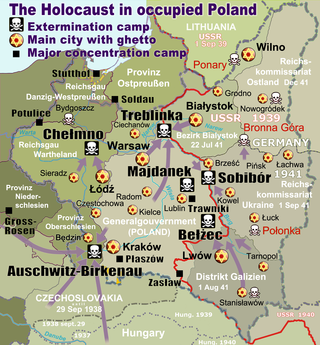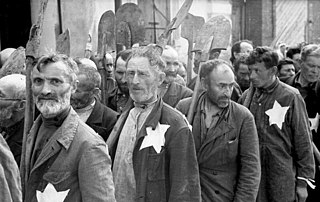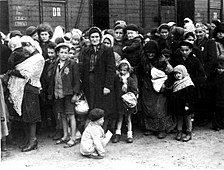
The Byelorussian Soviet Socialist Republic, also known as Byelorussia, Belarusian SSR, Soviet Belarus, or simply Belarus, was a republic of the Soviet Union (USSR). It existed between 1920 and 1991 as one of fifteen constituent republics of the USSR, with its own legislation from 1990 to 1991. The republic was ruled by the Communist Party of Byelorussia and was also referred to as Soviet Byelorussia or Soviet Belarus by a number of historians. Other names for Byelorussia included White Russia or White Russian Soviet Socialist Republic and Belorussian Soviet Socialist Republic.

Maly Trostenets is a village near Minsk in Belarus, formerly the Byelorussian Soviet Socialist Republic. During Nazi Germany's occupation of the area during World War II, the village became the location of a Nazi extermination site.

Slutsk is a town in Minsk Region, Belarus. It serves as the administrative center of Slutsk District, and is located on the Sluch River 105 km (65 mi) south of Minsk. As of 2023, it has a population of 60,376.

Lakhva is a village in Luninets District, Brest Region, Belarus. It serves as the administrative center of Lakhva selsoviet. It has a population of approximately 2,100.

The Dzyatlava Ghetto, Zdzięcioł Ghetto, or Zhetel Ghetto was a Nazi ghetto in the town of Dzyatlava, Western Belarus during World War II. After several months of Nazi ad-hoc persecution that began after the launch of Operation Barbarossa, the invasion of the Soviet Union, the new German authorities officially created a ghetto for all local Jews on 22 February 1942. Prior to 1939, the town (Zdzięcioł) was part of Nowogródek Voivodeship of the Second Polish Republic.

In the early modern era, European Jews were confined to ghettos and placed under strict regulations as well as restrictions in many European cities. The character of ghettos fluctuated over the centuries. In some cases, they comprised a Jewish quarter, the area of a city traditionally inhabited by Jews. In many instances, ghettos were places of terrible poverty and during periods of population growth, ghettos had narrow streets and small, crowded houses. Residents had their own justice system. Around the ghetto stood walls that, during pogroms, were closed from inside to protect the community, but from the outside during Christmas, Pesach, and Easter Week to prevent the Jews from leaving at those times.
The anti-Jewish violence in Central and Eastern Europe following the retreat of Nazi German occupational forces and the arrival of the Soviet Red Army – during the latter stages of World War II – was linked in part to postwar anarchy and economic chaos exacerbated by the Stalinist policies imposed across the territories of expanded Soviet republics and new satellite countries. The anti-semitic attacks had become frequent in Soviet towns ravaged by war; at the marketplaces, in depleted stores, in schools, and even at state enterprises. Protest letters were sent to Moscow from numerous Russian, Ukrainian and Belarusian towns by the Jewish Anti-Fascist Committee involved in documenting the Holocaust.

The Belarusian Auxiliary Police was a German force established in July 1941 in occupied Belarus, staffed by local inhabitants, considered collaborationist. In western Belarus, auxiliary police were formed in the form of Schutzmanchaften units, while in the east they were formed in the form of Ordnungsdienst.

ŁachwaGhetto was a Nazi ghetto in Łachwa, Poland during World War II. The ghetto was created with the aim of persecution and exploitation of the local Jews. The ghetto existed until September 1942. One of the first Jewish ghetto uprisings had happened there.

Krupki is a town in Minsk Region, Belarus. It serves as the administrative center of Krupki District. As of 2023, it has a population of 8,487.

The Grodno Ghetto was a Nazi ghetto established in November 1941 by Nazi Germany in the city of Grodno for the purpose of persecution and exploitation of Jews in Western Belarus.

Nikolay Yakovlevich Kiselyov, also commonly transliterated from the Russian language as Nikolai Kiselev, was a Soviet Red Army commissar, prisoner of war, and partisan leader during World War II.
Daniel Romanovsky is an Israeli historian and researcher who has contributed to the study of the Holocaust in the Soviet Union under German occupation in World War II. Romanovsky was a Soviet refusenik politically active since the 1970s. Private seminars on the history of the Jews were held in his Leningrad apartment in the 1980s. Research on the topic was difficult in the Soviet Union because of government restrictions. In the 1970s and 1980s Romanovsky interviewed over 100 witnesses to the Holocaust, including Jews, Russians, and Belarusians, recording and cataloguing their accounts of the Final Solution.
The Holocaust in Chachersk was the ghettoization and genocide of the Jews and Romani people mainly in the Belarusian shtetl of Chachersk, as well as in the greater Chachersk District located inside the Gomel Oblast during the Holocaust. Invading Soviet-controlled Belarus as a part of Operation Barbarossa, Nazi Germany subjected Chachersk and neighboring shtetls to systematic extermination. Entire Jewish and Romani populations in the region were rounded up in Nazi-organized ghettos and later murdered, in one of the earliest phases of the Final Solution.

The Słonim Ghetto was a Nazi ghetto established in 1941 by the SS in Slonim, Western Belarus during World War II. Prior to 1939, the town (Słonim) was part of the Second Polish Republic. The town was captured in late June 1941 by the Wehrmacht in the early stages of Operation Barbarossa. Anti-Jewish measures were promptly put into place, and a barb-wire surrounded ghetto had been created by 12 July. The killings of Jews by mobile extermination squads began almost immediately. Mass killings took place in July and November. The survivors were used as slave labor. After each killing, significant looting by the Nazis occurred. A Judenrat was established to pay a large ransom; after paying out 2 million roubles of gold, its members were then executed. In March 1942, ghettos in the surrounding areas were merged into the Słonim ghetto.

Baranavichy Ghetto was a ghetto created in August 1941 in Baranavichy, Belarus, with 8,000 to 12,000 Jews suffering from terrible conditions in six buildings. From March 4 to December 14, 1942, Germans killed nearly all of the Jews in the ghetto. Only about 250 survived the war, some of whom were helped by Hugo Armann, head of a unit that arranged travel for soldiers and security police. He saved six people from a murder squad and another 35 to 40 people who worked for him. Edward Chacza coordinated escapes with Armann and others so that Jews would meet up with partisan groups in the forest. He also provided food and arms.

The Navahrudak Ghetto was established in December 1941 in Navahrudak, in the Byelorussian SSR, during the Holocaust. Almost all of its residents were killed - only 350 survived, and 10,000 perished.
Generalbezirk Weißruthenien was one of the four administrative subdivisions of Reichskommissariat Ostland, the 1941–1945 civilian occupation regime established by Nazi Germany for the administration of the three Baltic countries and the western part of the Byelorussian SSR.

The Mogilev Ghetto was a Nazi ghetto in the city of Mogilev, in eastern Belarus, during World War II. Established shortly following the German victory in the Siege of Mogilev, around 10,000 Jews were killed by the Nazis and collaborationist forces by the time it was abolished in 1943.

The Ghetto in Svisloch was a ghetto for the forcefully relocated Jews of Svisloch in the Osipovichi district (Belarus), and nearby settlements. It was in operation during the Holocaust, from the summer of 1941 to autumn of 1942


















